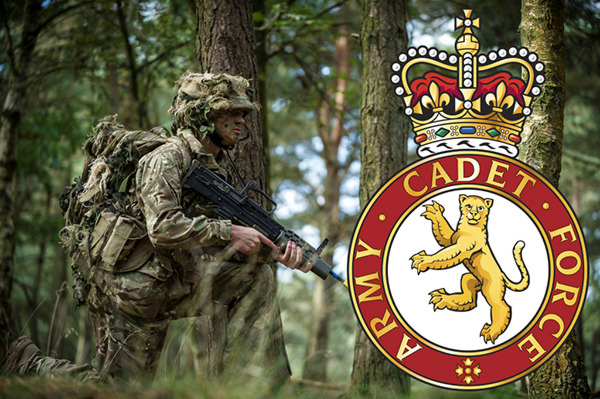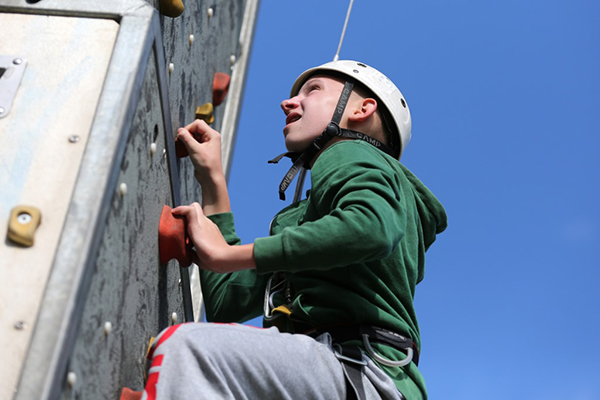The Army Cadet Force - Past & Present
THE EARLIEST DAYS
The Cadet Force can trace its beginnings to 1859. At that time there was a threat of a french invasion. Few units of the British Army were at home; most of them were serving in India after the Indian Mutiny. The Volunteers were formed because of the threat of invasion. The threat of invasion was again repeated in 1940 by the German Army.
THE VOLUNTEERS
The formation of the Volunteers (ancestors of the Territorial Army), saw the start of the Cadet Force. In 1860 at least eight schools had formed units. Volunteer units formed Cadet Companies. One of these, the Queen’s Westminsters, paraded their cadets when Queen Victoria carried out a review of the Volunteers in 1860.
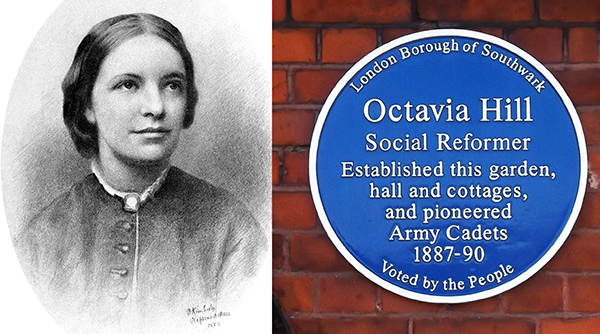
OCTAVIA HILL – SOCIAL WORKER
The Cadet movement continued, it was seen as being of great value and benefit to the boys who lived in the terrible conditions of the London slums. One of the most respected social workers of that time was Miss Octavia Hill. She realised that cadet training was of great benefit to these boys. The Southwark Cadet Company was formed as a result. This introduced the boys of the area to the virtues of order, cleanliness, teamwork and self-reliance. The story goes that she had contacts at the Woolwich Garrison and persuaded them that the boys who were living rough on the streets, could be accommodated in the stable haylofts at the Barracks. No doubt there were as many rats and mice there as on the streets. At least it would be dry and warm and they got fed regularly!
At the age of 26 she collected rents in Paradise Place, one of the most notorious slum areas in London. She was so angry and upset to see families living in such terrible conditions, that she decided to make it her mission in life to find or provide better housing for the poor. Today, as a result of her tireless energy and work Octavia Hill Housing Trust has a large number of properties in the London area.
Another passion in her life was the creation of open spaces in built up areas to bring “Healthy gifts of air and joy of plants and flowers”. Her public campaigns to save recreational open space accessible to all, led to the creation of the National Trust.
Cadets today can be justly proud that the voluntary spirit of Octavia Hill is part of their history and heritage.
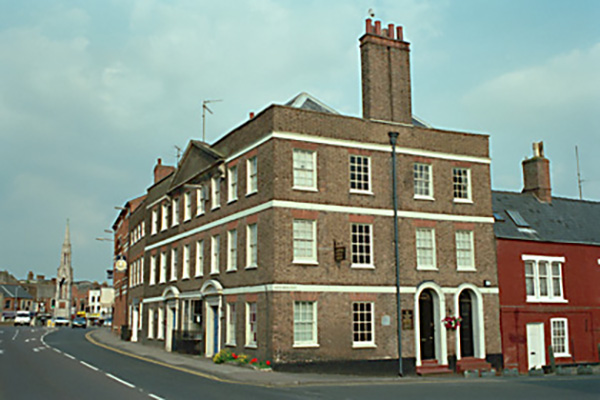
The Octavia Hill Museum in Wisbech
THE OCTAVIA HILL MUSEUM AND SOCIETY
The Octavia Hill Birthplace Museum preserves the memory and work of this lady. The museum is organised and staffed by the members of the Octavia Hill Society. The are all volunteers who give their time supporting the museum and staffing it.
The Army Cadet Force is well represented; a model of an Army Cadet was recently added to the display. Every Cadet should take the opportunity to visit the museum, which is located in the Cambridgeshire town of Wisbech.
THE BOAR WAR
At the start of the Boer War, about fifty schools had Cadet Corps (the forerunners of the Combined Cadet Force). Many ‘Open Units’ (forebears of the present Army Cadet Force) had started in the larger cities.
AFTER THE BOER WAR
In 1908, the Volunteers were converted to the Territorial Army. Public Schools and Universities were asked to provide units of the Officer Training Corps. Cadet Corps were formed in schools and ‘open units’ for those who had left school. The title Cadet Force was introduced and the administration was taken over by the Territorial Army Associations.
THE FIRST WORLD WAR
In 1914 during the Great War, there was a massive expansion of the Cadet Force. The War Office took over the administration, and continued until 1923 when control and administration reverted to the Territorial Army Association. In that year, 1923 the government ceased to recognize the Cadet Force, taking away all financial support. This was a very difficult period for everyone, but the voluntary spirit, that had been its greatest strength in the early days, came to the surface. Individuals had to find the funding for everything. The wearing of Regimental badges and buttons was forbidden. It was a difficult and unhappy time for the Cadet Force.
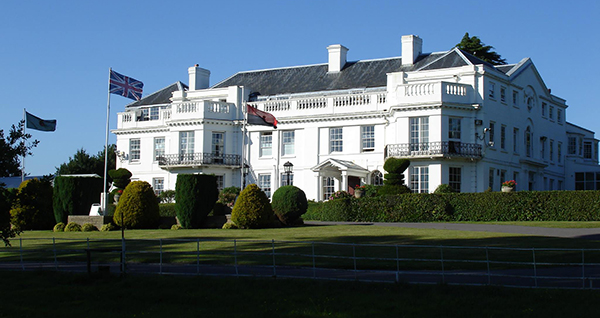 The cadet training centre, Frimley Park, Camberley, Surrey
The cadet training centre, Frimley Park, Camberley, Surrey
THE AMERY REPORT
In 1957 a special Government Report (The Amery Report), was published. It reported on the future organization and training of cadets in the immediate post war years. Many changes were made; Frimley Park, the Cadet Training Centre, was founded. The ACFA was one of the youth organisations given massive grants from the King George VI Memorial Trust Fund. As a result of this, the Cadet Officer and Instructor courses that are run at Frimley are called the KG VI Leadership Courses.
Cadet training took on a new direction, the war was over and National Service was about to cease. It then became more important to develop the cadet as a person, with more responsibility for their actions, guiding and developing them through their training to become good citizens.
THE DUKE OF EDINBURGH’S AWARD SCHEME
It was a happy coincidence that the Duke of Edinburgh’s Award Scheme started soon after the Adventurous Training was introduced into the ACF. As a result of this, the ACF became involved in the award scheme as an operating Authority, right from the start.
There are many benefits to be gained by taking part in the Award Scheme. It is recognised world wide for any individual who has achieved an award.
ADVENTUROUS TRAINING INTRODUCED
With the emphasis on this change of direction, Adventurous Training was introduced as a subject in the cadet syllabus. Special grants were made available to County Territorial Army Associations to set up County Adventurous Training Centres. Many Counties took advantage of this and set up Adventure Training Centres in their counties. Hopefully, many of you still have the opportunity to go on weekend training.
Quarter Guard. Christ’s College, Brecon, Cadet Corps 1898.
Annual camps were an established feature of the Volunteer Force and the custom soon spread to cadet units. Sometimes a camp would be organised by an individual unit, but increasingly combined camps became the order of the day. The first Public Schools Cadet Camp was held at Churn Downs in 1889.
The competitive element in these camps gave a useful incentive to training, drill and shooting competitions being keenly contested. Each unit in turn had to provide the camp quarter-guard and again there was keen rivalry to produce the smartest turn-out.
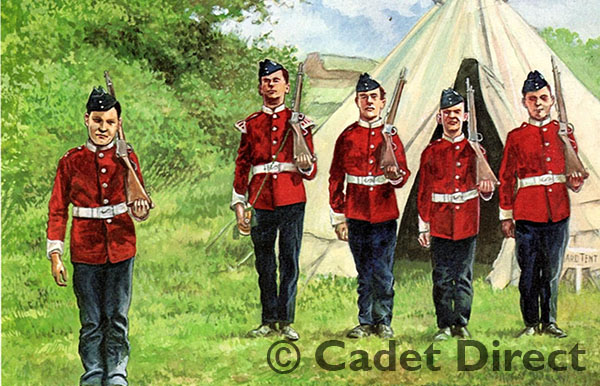 Quarter Guard of Christ's College Cadet Corps
Quarter Guard of Christ's College Cadet Corps
The quarter-guard of Christ’s College Cadet Corps is illustrated above. They wore dark blue field service caps and scarlet tunics with white collars and cuffs. Trousers are of dark blue serge with a scarlet welt down the outside seams. The bugler to the left carries the wing epaulettes of a bandsman. Belts of white buff leather are worn and the guard is armed with the cavalry version Martini-Henry rifles.
The Christ’s College Cadet Corps was formed in 1895 and became affiliated to the 1st. (Brecknockshire) Volunteer Battalion, South Wales Borderers. By 1908 it was down to only 35 cadets and was disbanded. It was revived in 1916 as a cadet corps but again disbanded in 1921. Finally, it re-formed in June 1937 as a unit of the Officers Training Corps.
Frimley and Camberley Cadet Corps 1909.
Surrey is a county which has always been strongly represented in the ranks of the Cadet Force. The Frimley and Camberley Cadet Corps was formed in 1908, largely at the instigation of a Miss G. M. I. Reynolds. Acting very much in the tradition of Octavia Hill, Miss Reynolds became concerned at the Cadet Corps lack of recreation facilities for older boys in her bible class. Her subsequent efforts led to the formation of a cadet corps.
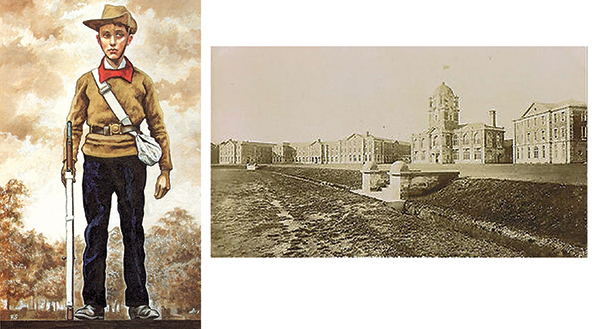
Frimley & Camberley Cadet Corps 1909 and The Royal Military College at Sandhurst (1912)
The uniform illustrated above was worn by the corps between 1908
and 1912, yet it has a curiously modern ring. A brown jersey was worn with a contrasting red collar, perhaps not so much a concession to informality, but as a means of providing a cheap uniform in days when the full cost had to be met locally. The real attraction for boys would be the slouch hat, an item of headgear which the South African War had made popular in both volunteer and cadet units. The cap badge took the form of the letters F&CCC in brass.The equipment worn was limited to a brown leather belt with brass clasp and a white haversack.
There was no lack of initial support for this unit and in 1909 Lord Roberts became its President. Curiously, official recognition did not come until 1912. In the same year, the unit became affiliated to the 5th. (T.F.) Battalion Queen’s Regiment, with the appropriate changes in uniform and badges.
The corps was fortunate in its location and adapted to the lean inter-war years better than most. The Royal Military College at Sandhurst was able to assist during this period with both instructors and second-hand uniforms. Since that time, the unit has survived and prospered; today it has close links with the 2nd Cadet BN The Queen’s Regiment, Surrey ACF.
NATIONAL CADET ASSOCIATION (BNCA)
Trying to keep the Cadet Force alive and at the same time trying to win back government support, brought about the formation of the BNCA. By 1932 the BNCA had gained recognition and achieved some measure of success. It was allowed, under the guidance of the Territorial Army – to run the Cadet Force.
THE SECOND WORLD WAR
Shortly after the start of the war, (1939-45), there was a massive expansion of all the Cadet Forces. Not only the Army Cadets and the Sea Cadets, they were joined by the newly formed Air Training Corps. By 1942 the War Office (known today as the Ministry of Defence), took over the administration of the ACF once again, giving it support beyond its members wildest dreams.
Uniforms were provided free and they had rifles issued (although they were from the Boer War period!) See the illustration below.
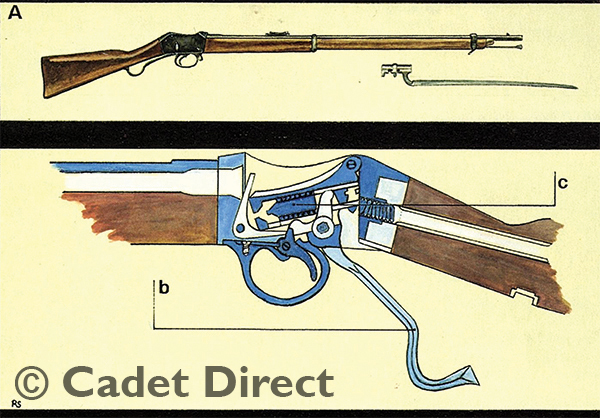
Martini Henery Rifle
This was the Martini Henery Rifle. The actual rifles issued were the Cavalry version, these being much shorter and more suitable for the Cadets to handle. They were for drill purposes only, which means they had their firing pins removed so could not be fired.
Annual Camp
Annual Camps were set up and assistance given to help run them and train the Cadets. The accommodation was mostly in bell tents, there were no beds, only sacks that the cadets filled with straw (called a palliasse) as a mattress to sleep on the duck boards in the tents. They were not very comfortable, especially when it rained - as it usually does at Annual Camp!
The War Certificate ‘A’ parts 1 and 2 was introduced as the Proficiency Tests for training, with the red star worn on the arm of uniforms similar to your APC red and blue stars today. At that time if a Cadet passed his Cert 'A' Part 2 it was an exception rather than the rule, as the standards were very high.
At one period there were more than 140,000 Army Cadets. The biggest problem was finding officers and instructors to run the Detachments. Most able-bodied men were already in the forces, committed members of the Home Guard or other Emergency Services, taking up any spare time they had.
During the early part of the Second World War, existing cadet units maintained their position, though many Cadet Force officers were lost to the forces, Home Guard or Civil Defence.
In April 1941 responsibility for cadets was transferred to the Home Guard Directorate, with the subsequent provision of increased cash grants, free uniforms and equipment. From January 1942 a massive expansion took place, assisted by Cadet Committees formed in each County area. A new title of ‘Army Cadet Force’ was introduced, to distinguish Army Cadets from the Sea and Air Cadet units which were forming. The original target for A.C.F. strength was fixed at 150,000 but by mid 1943 over 170,000 army cadets were serving. The age range was fixed at fourteen years to seventeen years.
Assistance with training came from a variety of sources. The Home Guard did a great deal, providing both instructors and weapons. Equally, local army units often gave help and at a more official level the army provided ‘Travelling Wings’ of some half dozen officers and N.C.O.’s for instruction and revision sessions. The pre-war Certificate ‘A’ examination of the O.T.C. was adapted as War Certificate ‘A’ and became the training aim. Camps were enthusiastically attended and in the summer of 1942, an estimated 100,000 cadets went to camp for a week.
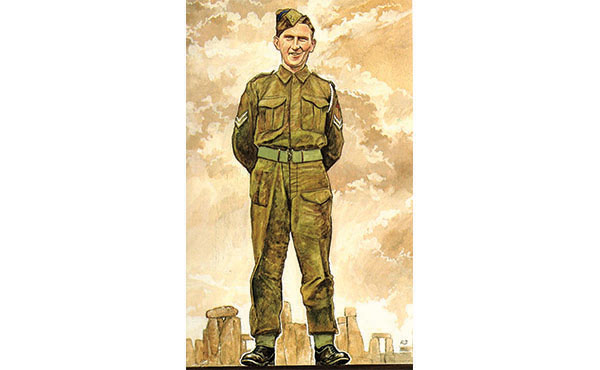
Wiltshire Army Cadet Force 1943
In the image above we show a member of the Wiltshire A.C.F. wearing battle-dress. Distinguishing features of cadet uniform included a deep blue backing to the peak flap of the khaki field service cap, also a printed shoulder title with the words CADET FORCE in black on a khaki background. The cap badge of the parent unit was worn, along with slip-on regimental titles of khaki cloth on the shoulder straps. The red star which denoted a pass in Certificate ‘A’ was worn on the left sleeve.
FORMATION OF THE ARMY CADET FORCE ASSOCIATION
In 1945 the British National Cadet Association changed its name to the Army Cadet Force Association, having spent some considerable time planning to meet the peace time needs of the A.C.F.
Growing in importance was the role of training for citizenship. An equally important factor was the continuation of National Service and the need to offer some form of pre-service training.
Some shrinkage of the A.C.F. took place immediately after the war and there was a further loss of some 100 school units in 1948 when they opted to join the newly organised Combined Cadet Force.
Amery Committee
In 1956 the Amery Committee was set up to report on the future organisation and training of the Cadet. The recommendations have provided the basis for all subsequent training with their equal emphasis on the development of character, the introduction of adventure training and leadership, and the acquisition of soldierly qualities. The ACF were one of the organisations to join the 'pilot' scheme for the introduction of the Duke of Edinburgh’s Award in the same year gave a firm direction to much of the thinking in the report. One important recommendation led to the establishment in 1959 of the Cadet Training Centre at Frimley Park.
ACF ONE HUNDRETH ANNIVERSARY
In 1960 came the centenary celebrations of the Army Cadet Force. Many Parades were held up and down the country when the newly presented Standard of the ACF was presented by His Royal Highness the Duke of Edinburgh. Another highlight of the year 1960 was a review of the ACF and CCF in the grounds of Buckingham Palace Majesty the Queen and His Royal Highness, the Duke of Edinburgh.
In the period from 1960 to the mid 1980s some counties had enrolled female cadets, initially as a pilot scheme, now of course they make a valuable contribution to the success of the Army Cadet Force.
NEW RIFLES INTRODUCED
1986 was a special ‘milestone’ in our history with the introduction of the L98. A1 Cadet GP Rifle made especially for the Cadet Forces.
The L81A2 Cadet Target Rifle was reintroduced to encourage more target shooting in the Cadet Forces. Initially there were some problems, which have now been rectified. There is an ever increasing number of teams that compete at Bisley and Pirbright each year.
1994 saw the replacement of the .303 Bren LMG. This was a much loved weapon by those who were marksmen. It had proved its worth in battle from the North African desert, the jungles of the far East. It was a simple action, easy to strip and clean. The Light Support Weapon (LSW) is the 5.56 Rifle (SA 80), with refinements making it ideal as the Section Fire Team weapon.
For a number of years Cadets spent their pocket money buying 1958 pattern webbing equipment in order to be up to date with the same appearance as the Regular Army Soldier. To everyones delight, 1958 Pattern webbing equipment was eventually issued to all County ACF's. At first it raised a few problems as some Cadets could put so much in all the different pockets and pouches that they were unable to lift it off the ground. This was solved by introducing sets of scales to check that the weight was under the permitted amount - one quarter of their own body weight.
The illustration further down in this artice shows a Royal Irish Ranger Cadet wearing Barrack Dress. Cadets on parade always looked so smart in their Barrack Dress instead of combat kit, sadly however, these were withdrawn.
In the year 2002 during an Annual Camp a female cadet lost her life as a result of an accident. As a consequence of this tragic accident, questions were asked as to who was responsible for and in charge of the Army Cadet Force. The short answer was, it was unclear at the time and to a great extent each County ACF did their own thing. So the Ministry of Defence, through HQ Land Command officially took over the ACF in the UK. At about this time TAVRA's (Territorial Army Volunteer Reserves Association) were re-named RF & CA (Reserve Forces & Cadet Association).
Many changes in the movement have been made. It might be said that the ACF is now more professional in its outlook and attitudes. Due in part to the Health & Safety regulations that have tended to restrict the level of many activities.
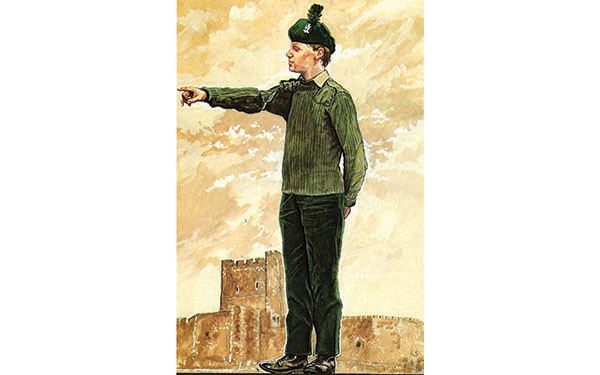
Royal Irish Rangers in barrack dress
Royal Irish Rangers
In the pre-war years, the authority of the various bodies controlling British cadets did not extend to Northern Ireland. Therefore, apart from some O.T.C. units, there is little early evidence of cadet activity. The Northern Ireland A.C.F. was formed in January 1943 and organised into battalions of the three Irish infantry regiments; the Cap badge Royal Inniskilling Fusiliers, the Royal Ulster Rifles and the Royal Irish Fusiliers.
After the war, cadet units became affiliated to the newly constituted Territorial Army units and a variety of cap badges were worn.
Strengths rose during the fifties with a greater emphasis on adventure training and the Duke of Edinburgh’s Award Scheme. In 1968 the detachments affiliated to the three infantry regiments were re-badged as the Royal Irish Rangers. The A.C.F. in Northern Ireland is now thriving and has 79 detachments supervised by 108 officers, 129 adult instructors and the number of cadets exceeds 1,700.
In the image above we show a cadet sergeant in barrack dress. Which was dark green trousers in a strong material. A woolly pullover and stable belt. He wears the distinctive dark green bonnet or caubeen of the Royal Irish Rangers, complete with green hackle. The brassard on his right arm carries an A.C.F. flash in white and green, dark green chevrons and various proficiency badges. In the background is Carrickfergus Castle.
150th anniversary
In 2010 the cadet movement celebrated its 150th anniversary with over 150 events in communities up and down the country - and beyond - under the banner of Cadet150. The main ceremonial event took place on 6 July. Over 1,700 cadets and adult volunteers paraded down the Mall for inspection by His Royal Highness The Prince of Wales. Joining friends and family and VIP guests for a garden party in the grounds of Buckingham Palace afterwards.
The Army Cadet Force today
The ACF is one of the UK's oldest, largest and most successful youth organisations. It has a long and proud history of preparing youngsters for all walks of life and encouraging an active involvement in local communities.

